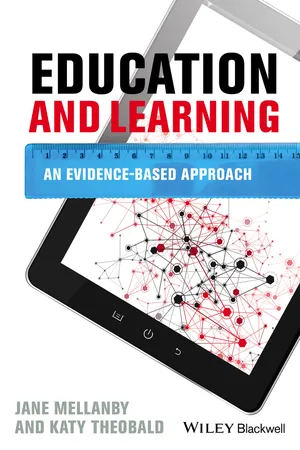Psychology
Influences on Intelligence
Influences on intelligence refer to the various factors that can impact an individual's cognitive abilities. These influences can include genetic predispositions, environmental factors such as education and socioeconomic status, as well as experiences and opportunities for cognitive stimulation. Understanding these influences is important in the study of intelligence and can help inform interventions and educational practices.
Written by Perlego with AI-assistance
Related key terms
7 Key excerpts on "Influences on Intelligence"
- eBook - ePub
Child and Adolescent Psychology
Typical and Atypical Development
- Stephen von Tetzchner(Author)
- 2018(Publication Date)
- Routledge(Publisher)
Chapter 5 , heritability estimates – the influence attributed to genes – is dependent on the environmental variation. If there is little environmental variation, the differences between individuals must mainly be caused by their genes, and vice versa. It is therefore of relevance that individuals from lower socioeconomic backgrounds are typically underrepresented in behavioral-genetic studies. The consequence will be a more narrow range of environmental variation, which will increase the heritability estimate and attribute less importance to environmental factors (Nisbett et al., 2012).Many hundreds of different genes are believed to be involved in cognitive development. Although thousands of children have been compared with regard to intelligence and genetic makeup, it has been difficult to single out the effects of individual genes, and many of the findings have not been replicable, indicating that they are chance findings (Chabris et al., 2012; Kleefstra et al., 2014). One finding in need of explanation is the fact that culture-dependent skills like vocabulary knowledge show a higher degree of heritability than skills that are not as culture-dependent, such as memory for digits and the ability to reconstruct a visual pattern (Kan et al., 2013). A possible explanation may be that some of the genes believed to be related to intelligence result in different degrees of environmental susceptibility. This is in line with research showing that children with a high IQ are more susceptible to experience than children with a low IQ (Brant et al., 2013).Environmental factors
Studies show that many environmental factors influence the development of intelligence. Nutrition during prenatal development and childhood has an impact on children’s intellectual development (Prado and Dewey, 2014). Longterm malnutrition can have permanent consequences, whereas the effect of shorter periods is reversible. However, it is not easy to distinguish the effect of nutrition from other factors: children who suffer from poor nutrition usually have parents who are undernourished themselves, live under difficult conditions and have little energy for interaction and play. The children may receive less stimulation and encouragement to pursue activities that promote intellectual development (Sigman and Whaley, 1998). In industrialized societies, lead and other contaminants are a possible source of cognitive problems (Dapul and Laraque, 2014; Needleman, 2004). - eBook - ePub
Cross-Cultural Psychology
Critical Thinking and Contemporary Applications, Sixth Edition
- Eric B. Shiraev, David A. Levy(Authors)
- 2016(Publication Date)
- Routledge(Publisher)
- According to the nativist approach to intelligence, human cognitive phenomena are inborn. They unravel as a result of biological “programming,” and environmental perception requires little active construction by the organism. There is evidence that heredity plays an important role in human intelligence. However, genetic links for individual differences and similarities do not imply that group differences—on the national level, for example—are also based on genetic factors.
- Some specialists imply that most intelligence tests benefit specific ethnic groups because of the test vocabulary—the words and items used in the test questions. Tests may contain internal bias because they use words that are familiar to only some groups. As a result, members of these groups receive higher scores than those who do not belong to these groups.
- Many environmental conditions have been found to influence performance on intelligence tests. Among them are availability of and access to resources, the variety of perceptual experiences, the predominant type of family climate, educational opportunities, access to books and travel, the presence or absence of cultural magical beliefs, general attitudes, and cultural practices.
- Intelligence scores are, in general, positively correlated with the socioeconomic status of the individual, and the link between socioeconomic conditions and test performance shows at an early age. A child’s IQ and the socioeconomic status of the child’s parents are also positively correlated. An affluent and educated family is likely to provide a better material environment for a child and also has more resources to develop the child’s intellectual potential than a poorer family. Poverty is responsible for a variety of indirect impacts on the intellectual development of children and adults.
- In the United States, people with high IQ scores are disproportionally represented among doctors, scientists, lawyers, and business executives. Individuals with low intelligence scores are disproportionally represented among people on welfare, prison inmates, single mothers, drug abusers, and high school dropouts.
- eBook - ePub
Education and Learning
An Evidence-based Approach
- Jane Mellanby, Katy Theobald(Authors)
- 2014(Publication Date)
- Wiley-Blackwell(Publisher)
- Empirical research suggests that individuals with higher IQ scores have: a different pattern of neural maturation; larger brains; greater grey- and white-matter volume; more efficient neural use of glucose in the brain during well-practised tasks; and more efficient neuronal connectivity. These structural differences indicate that it is reasonable to employ the concept of IQ and to expect IQ variations to be reflected in other tests of cognitive performance, including academic measures.
- The heritability of IQ ranges from about 25% in early childhood to 80% in adulthood, whilst the heritability of specific abilities varies widely. The impact of genes co-varies with the environment, so that people with similar genes may have differing IQs depending upon their experience.
- Amongst interventions purported to boost children's IQs, there is little evidence that learning a musical instrument or taking dietary supplements in later life is effective. Early childhood diet may be important, however, and sustained brain training programmes may also have some impact on IQ test scores, if not on intelligence itself.
Educational implications
- Some theories of intelligence that are popular with educators, such as Multiple Intelligences, do not actually have strong empirical support, and should therefore be employed with caution. Nonetheless, adopting a broad view of intelligence can ensure that pupils with non-academic strengths still feel valued and successful in an educational environment.
- A predominant focus on verbal and mathematical skills in schools can result in the strong spatial abilities exhibited by some pupils being overlooked and undervalued. Pupils with strong spatial abilities excel in STEM subjects, so educators and politicians should consider how to adapt the modern curriculum and teaching methods to use and reward these skills more frequently.
- Given the academic benefits of pupils adopting incremental theories of ability, teachers should be careful to praise effort rather than intelligence. Educators might also try to avoid signalling that ability is fixed, for example by not explicitly labelling ‘gifted and talented’ pupils and by not grouping pupils by ability from a young age.
- eBook - ePub
WISC-V
Clinical Use and Interpretation
- Lawrence G. Weiss, Donald H. Saklofske, James A. Holdnack, Aurelio Prifitera(Authors)
- 2019(Publication Date)
- Academic Press(Publisher)
At some point in the future, we expect that researchers will cease using racial/ethnic status groupings because of the fluidity of racial boundaries and the wide variability of culture and language within racial and ethnic groups. Future researchers may wish to study how socially constructed concepts of culture mediate development of the particular cognitive abilities assessed by most major intelligence tests in industrialized countries.At this point, we leave behind the study of racial/ethnic differences in intelligence, and hope that others will do the same. We now turn the proverbial corner and begin a preliminary discussion of home environment variables that enhance children’s cognitive development within and across cultural groups. In the remainder of this chapter, we present initial data regarding home environment and language variables, and impact on cognitive development and cognitive ability test scores.Further Considerations of Home Environment on Intellectual and Academic Development of Children
Many of the SES-related variables typically studied in intelligence research are assumed to operate on children’s development in two ways. First, there are the distal effects of the environment in terms of school quality, neighborhood safety, medical care, etc. Many of these are assumed to be captured indirectly by parent education and income level. Second, there are the proximal effects of how parents interact with children in terms of providing linguistically, intellectually, and academically stimulating and encouraging environments. Parent–child interactions may or may not be related to parent education and income. We treat these variables separately because, unlike SES, parents’ß behaviors and attitudes are more within their immediate control.Implicit assumptions are often made about the manner in which more educated mothers interact with their children in different ways from mothers with less formal education. More educated mothers are assumed to provide increased language stimulation to infants and toddlers, read more often to preschool-age children, assist elementary school children more with homework, and generally provide more intellectually stimulating activities throughout childhood and adolescence. This is a broadly sweeping assumption that deserves to be examined in more detail. It is quite possible that there is considerable variability in parenting practices within SES groups, and that this variability influences the cognitive development of children. - eBook - ePub
- Peter Mitchell, Fenja Ziegler(Authors)
- 2013(Publication Date)
- Psychology Press(Publisher)
11 DOI: 10.4324/9780203736357-11Contents
Introduction What is inherited? Intelligence: Heredity versus environment Describing and testing the concept of intelligence Problems with testing intelligence Heritability of intelligence Evaluating the twin studies Environmental factors and IQ The social environment IQ, elitism, and racism SummaryThe role of heredity and environment in intelligence 11
Chapter Aims- To introduce the concept of intelligence
- To introduce ways in which intelligence is measured.
- To assess the roles of nature and nurture in intelligence.
- To highlight some of the problems faced when testing intelligence.
Introduction
Intelligence really matters to people’s lives; those that are deemed intelligent are perceived to be cut out for better jobs and more prosperous and fulfilling lives. The idea of intelligence as a measurable entity is only about a 100 years old, and yet it is firmly ingrained in our folk psychological perception of ourselves and others that we can be ranked in terms of our intelligence. One of the central questions that researchers have investigated is whether intelligence is inherited or whether it is a result of education and other environmental factors, in other words, it figures in the nature–nurture debate. Unlike some other topics, this debate reaches beyond the realms of academia and pure scientific interest because intelligence is assigned such high status in our society and, moreover, it has implications for educational and social policy. In this chapter we look at how intelligence is measured and reflect on the role of nature and nurture.What is Inherited?
Before we look specifically at intelligence, it is worthwhile establishing more generally whether there is some way of telling which part of the way we are, and the way we behave, is determined by the genes passed on to us from our parents. At a glance, this may seem a simple question to answer. All we have to do is watch newborn babies: They have had little or no time to learn and so presumably whatever they can do is determined genetically, and therefore is likely to be inherited from the mother, the father, or both. By observing newborns we could compile a long list of behaviors: crying, swallowing, blinking, defecating, sucking, yawning, sneezing, coughing, grasping, etc. - eBook - ePub
Understanding Psychology for Medicine and Nursing
Insights and Applications
- Mohamed Ahmed Abd El-Hay(Author)
- 2019(Publication Date)
- Routledge(Publisher)
Social relationships play a vital role in a child’s cognitive development. Play is one of the first social interactions that contribute to a child’s ability to learn. Later, as a child becomes involved in different social activities with other children, he or she learns how to solve problems. Cultural influences also affect a child’s cognitive development, with one of the most persistent cultural influences being the school system. Much of what children learn is the particular ways their culture views reality, the roles of different people and different sexes, and the rules and norms that govern social relationships in their particular culture. In these areas there are no universally valid facts or correct views of reality.Psychological Factors
The quality of caregiving, especially maternal, is a strong indicator of a child’s cognitive abilities and social competence. Families provide a nurturing environment in which security, protection, satisfaction, and love are given. Physical needs for food and clothing are met. In this environment, family members grow to maturity. Parenting style is another factor that affects a child’s cognitive development. A parent’s values and beliefs influence how a child understands what goes on around him. Some parenting styles may be unresponsive to a child’s needs; others encourage academic achievement, self-confidence, independence, and maturity. However, finding actual cause-and-effect links between specific actions of parents and later behavior of children is very difficult. Some children raised in dramatically different environments can later grow up to have remarkably similar personalities. Conversely, children who share the same home and are raised in the same environment can grow up to have astonishingly different personalities to one another.Despite these challenges, researchers have uncovered convincing links between parenting styles and the effects these styles have on children. However, there is no universally “best” style of parenting. It is probably the fit between the particular style and the particular child that affects the child. Parenting styles must be evaluated in terms of their cultural context. Researchers have identified four basic parenting styles: - eBook - ePub
Intelligence
A New Look
- Hans Eysenck(Author)
- 2018(Publication Date)
- Routledge(Publisher)
5 The Biological Basis of IntelligenceAlthough Galton suggested reaction time and similar tests as biological measures of brain functioning, they are obviously just a halfway house in that direction. What he had in mind did not then exist, namely electronic ways and means of investigating directly what was going on in the brain, such as the electroencephalograph, the positron emission tomography (PET) scan, or the magnetic resonance imaging technique. In turning now to results established with the use of such modern techniques, it may be useful to consider Figure 5.1 which contrasts three different conceptions of intelligence.This figure shows on the left, the hypothesized biological background of intelligent behaviour. Genetic factors determine neurological structures, physiological mechanisms and biochemical secretions, the interplay of these with each other, and with the information constantly impinging on the cortex through the messages brought to it by the ascending afferent pathways. Those messages are transmitted through the brain, from cell to cell, through the synapses that link the axons of one cell with the dendrites of another (or indeed many others!) We can measure what is going on in the brain by means of the EEG, by recording averaged evoked potentials, the contingent negative variation, the galvanic skin response, and so on. This is what is meant by biological intelligence. (I shall explain some of these concepts presently.)Differences in this biological intelligence can be measured by means of IQ tests, but only indirectly, and with an admixture of inputs from many environmental sources—socioeconomic status, education, family upbringing, cultural factors, and so on. This is psychometric intelligence or IQ, and we have already discussed this fairly thoroughly. Finally, we have social or practical intelligence, for example, the application of IQ to worldly affairs, like earning a living, engaging in marriage, or interacting with other people. Success in all this is partly due to IQ, but here we also have a whole host of external factors, all of which may influence the outcome—personality, mental disorder, drinking habits, motivation, nutrition, health, and above all, luck. Clearly, this social or practical intelligence is too complex a concept to be of any scientific value; science relies on the reduction of complex concepts to simpler, more elementary ones.To bring in other completely unconnected factors in this fashion is not useful; we would want to study each separately, and also its interaction with all the others. RT and IT studies straddle the space between biological intelligence and psychometric intelligence; we must now turn to a consideration of biological intelligence itself.
Learn about this page
Index pages curate the most relevant extracts from our library of academic textbooks. They’ve been created using an in-house natural language model (NLM), each adding context and meaning to key research topics.





